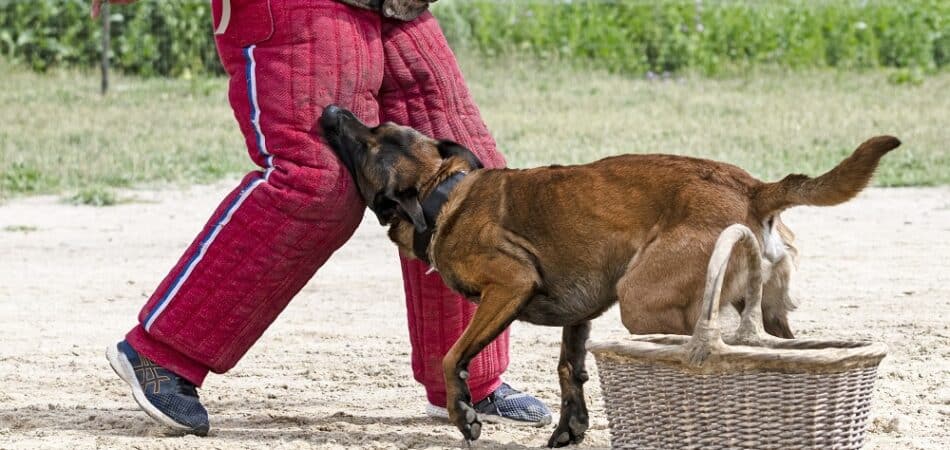






Bite inhibition is your dog’s ability to regulate the force of their bite. Puppies learn it naturally through play—bite too hard, and their littermates yelp or stop playing.
But a protection dog isn’t just a pet. They need to know when to grip, when to release, and how much pressure to apply.
A well-trained dog bites with intent, not recklessness. They don’t just bite because they can; they bite because the situation demands it. And when that situation passes, they release on command—no hesitation, no conflict.
But how do you teach your dog to balance intensity with control?
Well, let’s walk you through the process.
 A protection dog isn’t born with perfect bite control—it’s developed through careful training that starts from the earliest stages of life. Puppies naturally use their mouths to explore, play, and interact, but that instinct must be refined into precision in a working dog.
A protection dog isn’t born with perfect bite control—it’s developed through careful training that starts from the earliest stages of life. Puppies naturally use their mouths to explore, play, and interact, but that instinct must be refined into precision in a working dog.
Early training isn’t about aggression; it’s about teaching the dog that biting is a tool to be used with control, not reckless force.
At this stage, the focus is on channeling their natural drive into structured behaviors. Puppies begin by learning the difference between play, exploration, and a controlled bite. They’re introduced to gentle resistance exercises to develop grip strength without overexerting force.
Trainers also work on impulse control, reinforcing that biting is not a free-for-all reaction but a deliberate response to a handler’s command.
Release cues, grip adjustments, and situational awareness are subtly introduced to lay the groundwork for more advanced training.
This foundational work ensures that when real training begins, the dog is already conditioned to bite with purpose—not just instinct.
A dog without rock-solid obedience has no business in bite work. Before you even think about reinforcing bite inhibition, your dog should have impeccable control over essential commands like sit, stay, down, heel, and recall—even under distraction.
It’s one thing for a dog to obey in a quiet backyard; it’s another to maintain discipline when surrounded by moving people, loud noises, or high-energy environments.
This level of control is non-negotiable. If your dog won’t release a ball on command, do you really think they’ll let go of an arm in a high-adrenaline situation?
Your release command should be non-negotiable. “Out” means out. Not “loosen your grip,” not “think about it,” but an immediate disengagement. And that command should work under any condition—whether your dog is biting a sleeve, a tug, or a real threat.
Use structured exercises like:
The goal? Your dog should release like flipping a switch—no hesitation, no struggle.
Control takes center stage here. And one of the most effective ways to build this control is through gradual pressure adjustments. By having the dog bite softer objects first—such as tug toys or softer sleeves—they learn to regulate their grip.
This prevents them from instinctively crushing everything they bite and reinforces the idea that a controlled bite is more effective than an all-out chomp.
Over time, resistance is increased, allowing the dog to refine their bite strength based on the target.
Out-then-re-engage drills play a crucial role in preventing frustration during bite training. Many dogs struggle with the idea that releasing means the game is over, leading to hesitation or outright refusal to let go.
These drills teach that “out” doesn’t signal the end of the engagement—it simply means they’re waiting for the next command.
When done correctly, this keeps the dog engaged while reinforcing impulse control. Instead of fixating on holding the bite at all costs, they learn to respond fluidly to their handler’s direction.
To further develop adaptability, trainers use varying resistance levels by introducing different bite surfaces. Dogs are trained to bite sleeves, padded suits, and hidden sleeves, each offering a unique texture and level of resistance.
This prevents them from becoming overly reliant on a single piece of equipment and ensures they can apply the same level of control in real-world scenarios, where a target won’t always be wearing a bite suit.
Bite inhibition requires decision-making under pressure. A dog that performs flawlessly in a controlled environment but crumbles in unpredictable situations? That’s a problem.
The fix? Stress inoculation. Your dog needs exposure to unpredictable, high-pressure scenarios—ones that mimic the chaos of a real confrontation. Without this, their bite control is just theory.
Slap a muzzle on your dog, and suddenly, biting isn’t an option. This forces them to use body pressure—pushing, driving, pinning—rather than defaulting to their teeth.
It also reveals something crucial: Does your dog panic without the ability to bite? If so, they’re relying on their mouth instead of their mind. That needs fixing.
A dog that only bites a puffy sleeve isn’t trained—it’s conditioned. Hidden sleeve training forces them to target based on intent, not equipment.
This eliminates the “bite the guy in the big jacket” mindset and ensures they engage threats—not just recognizable gear.
In the real world, threats don’t stand still and wait for a cue. Your dog needs exposure to:
If they freeze, hesitate, or overreact in training, they’ll do the same in real life. And when seconds matter, you don’t want a dog second-guessing—or worse, making the wrong call.
Two of the biggest threats to a protection dog’s reliability? Overstimulation and frustration. A dog that’s too amped up won’t think—just react. A frustrated dog may act on impulse instead of training. The goal is to keep their drive high without tipping into chaos.
Watch for excessive re-biting or thrashing. If they keep adjusting their grip or shaking the target wildly, they’re running on instinct, not discipline. And in a real-world scenario, that lack of control can turn precise engagement into reckless aggression.
Another red flag is delayed release. Hesitation—even for a split second—is still disobedience. If a dog lingers on a bite, they’re either unsure, overstimulated, or pushing boundaries. That means it’s time to reinforce obedience work.
Finally, be wary of hyper-fixation. If they lock in and refuse to redirect, they’re thinking emotionally instead of strategically. That’s a problem.
The standard is simple: instant clarity. When a command is given, there should be no delay, no hesitation, no resistance—just action. Anything less needs fixing.
Training tools shape a dog’s bite and the right equipment ensures they learn precision, not just power. Some of the essentials include:
Combined with expert handling, these tools turn natural bite instinct into a controlled, tactical response.
Even experienced handlers make mistakes that can erode a dog’s control.
Here’s what to avoid:
🐾Letting your dog “win” without a release – If they learn they can keep the grip as long as they want, good luck getting them to let go in a real scenario.
🐾Overcorrection – Too much correction can make a dog hesitant, affecting their confidence.
🐾Over-relying on e-collars – An e-collar should reinforce, not replace, proper training.
🐾Lack of real-world proofing – If your dog only trains in a sterile environment, their inhibition won’t hold up in high-pressure situations.
🐾Inconsistent commands – If “Out” sometimes means “let go,” but other times means “ease up,” you’re setting your dog up for failure.
Yes….it’s not impossible—but it’s not for the inexperienced. This isn’t basic obedience. It’s not teaching “sit” or “stay.” You’re shaping controlled aggression, precise targeting, and instant release under pressure.
The biggest challenge? Teaching bite inhibition while maintaining drive. And to be successful in this training, you need to have a thorough understanding of what fuels their behavior and know why they bite.
That comes down to four key drives:
Each of these drives plays a critical role in how a dog engages with a threat, and if you don’t understand how to channel them correctly, you’ll either build an ineffective dog or one that’s outright dangerous.
That’s why real protection training isn’t a DIY project.
So, when asked, “Where do I start training a protection dog?” I recommend getting an experienced protection dog trainer to guide you through the process.
An experienced trainer will assess your dog’s natural tendencies, help you refine their drives, and, most importantly, prevent mistakes that could turn into long-term liabilities.
At Vanguard Protection Dogs, we’ve spent years perfecting our bite inhibition training methodology—ensuring dogs develop the control, confidence, and precision needed for real-world protection.
So, if you’re serious about training a real protection dog, don’t go at it alone. Start with expert guidance, invest in structured training, and get it done right the first time.
Now, schedule a free consultation today and we’ll address your concerns or doubts about bite inhibition training in protection dogs.
During your private consultation, you’ll receive: